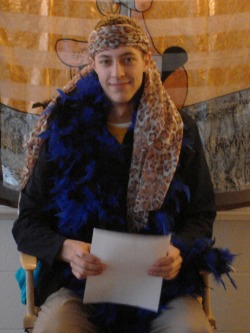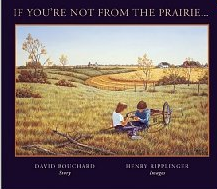Narrative writing

THIS I BELIEVE
This I Believe is a segment from NPR that is extremely effective when used in class. NPR has published a collection of some of their finest statements along with a CD to actually listen to author reading his/her statement. I have started this mini-unit with the essay entitled "Be Cool to the Pizza Delivery Dude", and kids just love it. The author takes such a simple idea and proposes a way of life based on this simple rule. After reading several more belief statements, students are asked to make a list of 5 things that really bother them as well as 5 things they feel really strongly about. For this exercise, I encourage kids to think beyond what they would consider their "core values" and include at least 2 ideas from each list that could be trivial (my hope here is that they then take something trivial and attempt to mimic the message from the Pizza Delivery Dude essay). Once this list is created, students are asked to create their own This I Believe statement. Since these essays are intended to be read aloud, a publishing day is a great finale to this unit. I created a coffee house in my room with lights, decor and coffee, of course. Each student orally shared his/her belief statement (the above picture is one student in the director's chair - donned for his rendition of This I Believe!). My students had a ball with this day, and it was so enjoyable to hear what my students are truly passionate about. Additionally, students can submit their essays to http://thisibelieve.org/submission/. Below is a student sample of his belief statement entitled "A Voodoo Child Speaks His Peace".
Connect to NPR for "Be Cool to the Pizza Delivery Dude"
This I Believe is a segment from NPR that is extremely effective when used in class. NPR has published a collection of some of their finest statements along with a CD to actually listen to author reading his/her statement. I have started this mini-unit with the essay entitled "Be Cool to the Pizza Delivery Dude", and kids just love it. The author takes such a simple idea and proposes a way of life based on this simple rule. After reading several more belief statements, students are asked to make a list of 5 things that really bother them as well as 5 things they feel really strongly about. For this exercise, I encourage kids to think beyond what they would consider their "core values" and include at least 2 ideas from each list that could be trivial (my hope here is that they then take something trivial and attempt to mimic the message from the Pizza Delivery Dude essay). Once this list is created, students are asked to create their own This I Believe statement. Since these essays are intended to be read aloud, a publishing day is a great finale to this unit. I created a coffee house in my room with lights, decor and coffee, of course. Each student orally shared his/her belief statement (the above picture is one student in the director's chair - donned for his rendition of This I Believe!). My students had a ball with this day, and it was so enjoyable to hear what my students are truly passionate about. Additionally, students can submit their essays to http://thisibelieve.org/submission/. Below is a student sample of his belief statement entitled "A Voodoo Child Speaks His Peace".
Connect to NPR for "Be Cool to the Pizza Delivery Dude"
| a_voodoo_child_speaks_his_peace.pdf |
| this_i_believe_rubric.pdf |
| hmwk_after_believe_essay.pdf |

IF YOU'RE NOT FROM THE PRAIRIE
Too often when students are asked to write a narrative, they produce an autobiography instead. Using If You're Not From the Prairie is a great way for students to start thinking about themselves and what is unique to them. By asking students to create an "on demand" writing of their own If You're Not _________ Then _____________, each student has almost immediately focused in on a small moment which could become the basis for a narrative essay. Students really enjoy the stress free environment that this activity creates, and I was amazed at the products students created. Below is a sample of some student produced on demand writing in the if you're not from format.
Connect to Amazon for book information
WHAT YOU KNOW FIRST
This children's book is similar to If You're Not From the Prairie and can be used to create the same desired outcome.
Connect to Amazon for book information
| if_you_re_not_from_the_prarie_sample.pdf |

BRAINSTORMING-- MAP ACTIVITY
For this activity, students begin to brainstorm a place. First, the teacher creates a list of places that are important in his/her life. When modeling, the teacher should work to model example places that are too big, just right and too small (to help with the next step). Then, the students follow suit-- brainstorming a list of places they remember vividly. After this, the teacher models narrowing down the places, eliminating those that are too big and those that are too small. He/She also stars three-- the three that he/she thinks have the best potential for interesting stories. After the students do the same, the teacher models telling a bit about his/her places to a "small group" (the class). Then students do the same in groups of 3 or 4, listening for which places they would want to hear more about and sharing that feedback with the speakers. After students have narrowed to one place, the teacher models drawing an overhead view map of that place, with as many details as possible. This process activates students' brains to begin composing stories before even writing-- they fill in many details that they will later capture in their personal narrative. After the maps are drawn, students return the next day with their maps to share with their peers, again staring at least 3 areas on the map where interesting things happened. The teacher models telling his/her stories for the class, allowing them to vote on the one that should be the topic for the personal narrative writing. Then students break into small groups to share their stories, again gathering feedback from the group. Eventually they narrow to a specific story in a specific place. This sequence encourages students to avoid the "and then... and then..." narratives that often span the course of an entire vacation or an entire sports season. They narrow to a snapshot rather than the whole photo album of memories.
For this activity, students begin to brainstorm a place. First, the teacher creates a list of places that are important in his/her life. When modeling, the teacher should work to model example places that are too big, just right and too small (to help with the next step). Then, the students follow suit-- brainstorming a list of places they remember vividly. After this, the teacher models narrowing down the places, eliminating those that are too big and those that are too small. He/She also stars three-- the three that he/she thinks have the best potential for interesting stories. After the students do the same, the teacher models telling a bit about his/her places to a "small group" (the class). Then students do the same in groups of 3 or 4, listening for which places they would want to hear more about and sharing that feedback with the speakers. After students have narrowed to one place, the teacher models drawing an overhead view map of that place, with as many details as possible. This process activates students' brains to begin composing stories before even writing-- they fill in many details that they will later capture in their personal narrative. After the maps are drawn, students return the next day with their maps to share with their peers, again staring at least 3 areas on the map where interesting things happened. The teacher models telling his/her stories for the class, allowing them to vote on the one that should be the topic for the personal narrative writing. Then students break into small groups to share their stories, again gathering feedback from the group. Eventually they narrow to a specific story in a specific place. This sequence encourages students to avoid the "and then... and then..." narratives that often span the course of an entire vacation or an entire sports season. They narrow to a snapshot rather than the whole photo album of memories.
| map_model.pdf |
